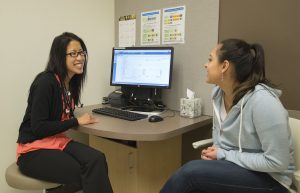With the days growing shorter and the sky darkening, the UW Neighborhood Olympia Clinic is starting to see patients whose moods match the gloomy weather. They are tired, sleep long hours and have trouble getting out of bed or leaving the house.
If these complaints sound familiar, they may mark the onset of winter seasonal affective disorder (SAD). This type of depression is thought to be caused by the effect of reduced natural daylight on brain chemicals that regulate our sleep patterns and mood.
Talk with your primary care provider if you’ve experienced SAD symptoms for several years. Once they’ve confirmed a diagnosis, they can discuss these common treatment options.
Light therapy

The first line of treatment for most people is light therapy. They sit in front of a light box that delivers high-intensity white fluorescent light for about 30 minutes a day. According to the National Alliance on Mental Illness, 50 to 80 percent of daily light box users experience an essentially complete remission of symptoms when they continue treatment into spring.
The “dawn simulator” is another light therapy that can be used alone or in conjunction with a light box. This light mimics a natural sunrise. It turns on early in the morning and gradually increases in brightness to awaken people more naturally without an alarm.
Let your doctor know if your mood fails to improve after several weeks of light therapy. You should also see your doctor immediately if you have severe symptoms of seasonal depression, such as difficulty functioning at work or home, or if you are feeling unusually sad and blue. In these cases, more aggressive treatments using antidepressant medications and cognitive behavioral therapy may be necessary.
Diet and exercise

For seasonal affective disorder, as for other types of depression, the benefits of regular exercise and a healthy diet cannot be overemphasized. A daily walk is a great start, or you can take advantage of the many opportunities for indoor and outdoor recreation that the Pacific Northwest offers year-round.
Finally, while many people find that these therapies – alone or in combination – can help to prevent or alleviate the symptoms of seasonal depression, some patients find that one other instruction is helpful at this time of the year. Along with shorter days, the arrival of fall often brings increased stress: summer vacations are over, school starts, and the holidays are around the corner. Enjoyable activities are needed to counter stress and keep our spirits up, so remember to have fun.
The UW Neighborhood Olympia Clinic is open six days a week, including evenings, and offers comprehensive patient- and family-centered primary care for the entire family throughout all stages of life. For more information about the UW Neighborhood Olympia Clinic and to make an appointment, visit uwmedicine.org/inolympia or call 360.507.9100.




















































